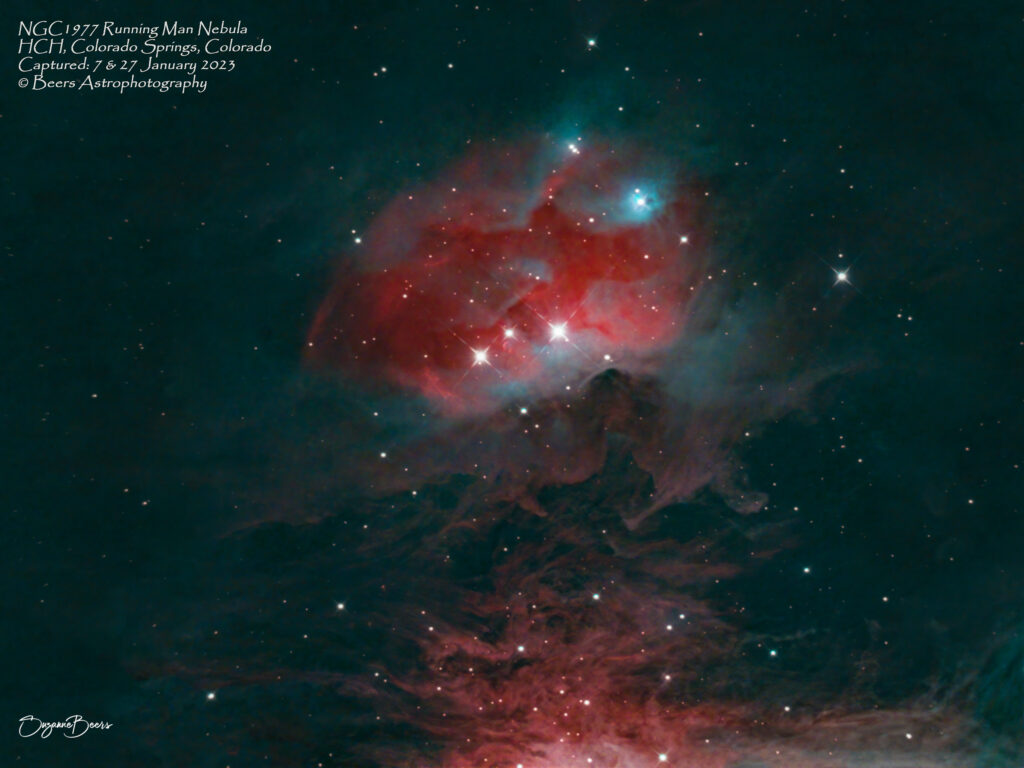
Target fun facts
Sh2-279 is an HII region and bright nebulae that includes a reflection nebula located in the constellation Orion. It is the northernmost part of the asterism known as Orion’s Sword, lying 0.6° north of the Orion Nebula. The reflection nebula embedded in Sh2-279 is popularly known as the Running Man Nebula. Sh2-279 comprises three NGC nebulae, NGC 1973, NGC 1975, and NGC 1977 that are divided by darker nebulous regions. It also includes the open cluster NGC 1981. The brightest nebulosity, later listed as NGC 1977, was discovered by William Herschel in 1786. The two smaller reflection nebulae were first noted by German astronomer Heinrich Louis d’Arrest, NGC 1973 in 1862 and NGC 1975 in 1864. All three were included in the New General Catalogue in 1888. The designation NGC 1977 is used in various sources for the reflection area around 42 Orionis (the south-east portion of the reflection nebula), for the entire reflection nebula (including NGC 1973 and NGC 1975), or for the whole nebula complex.
The region is 1500 light years from earth and about 15 light years in diameter (apparent dimensions of 40’ x 25’) in the Orion constellation. As described above, the Running Man is known as:
Other Catalog Designations: SH2-279 and NGC1973, NGC1975, and NGC1977
Subtype: Bipolar Nebula
Distance from Earth: 1500 light years
Size: 15 light year (diameter)
Constellation: Orion
{From: https://en.wikipedia.org/wiki/Sh2-279 and Stellarium}
Capture Notes
7Jan2023: After almost a month of bitter cold, wind, and clouds over the holiday season, we finally had a clear night (partially – from dark until about 0100), so I decided to take advantage of it with Big Zeus, the LeXtreme filter (because it was the 99.2% waning gibeous moon, after Friday night’s full moon). I knew that I wouldn’t get the rich colors on the Running Man that I get in dark skies, but I can’t get the Big Zeus “close up” look there – so that’s what I spent the evening on. Got started just as NGC1977 was rising (had to decrease the HCH horizon value to 15%, because it was set at 20% – when the target was at 18% the SGP go-to would immediately fail). I woke up at about 0030MST to see low clouds over the mountain – NGC1977 was still visible, but when I saw the thick layer of frost on Big Blue (our F-350 that is parked outside below the front patio where I was shooting), and had noticed the towel I was using to wrap the laptop was a bit damp each time I went out to attend to the set-up, I decided that I should rescue the equipment from the frost. The images were still coming in fine, but there was a bit of frost on the secondary mirror arms.
27Jan2023: After returning home from the DAF SAB Winter Board meeting, as I was in the bedroom closet beginning to unpack, I did a quick search of Weather Underground (mostly to find out the weather for the following morning’s run) only to find it was going to be clear. Even though I was exhausted from the DAF SAB trip (and it turned out that I also had contracted COVID during the trip!) I couldn’t pass up the opportunity for a clear night while the winter targets were still in full view. So I quickly regrouped (yes, I did complete the process of unpacking and getting my running clothes for the next morning ready first!) and set up Big Zeus on the front patio to collect more data on NGC1977 Running Man Nebula.
Equipment
Polar alignment: QHYCCD camera (controlled by Polemaster)
Imaging stream: Orion 10″ f/8 Ritchey-Chretien Astrograph Telescope, Canon EOS Ra with with Teleskop Service Flattener 1.0x for RC Telescopes (TS-RCFLAT2) and Optolong L-Extreme LP filter.
Mount: Sky-Watcher EQ6-R Pro Equatorial Mount (controlled by EQMOD)
Autoguider: Orion 60mm Multi-Use Guide Scope, Orion StarShoot AutoGuider Pro Mono Astrophotography Camera (controlled by PHD2)
All equipment controlled by HP Probook running Sequence Generator Pro v3.2.0.660.
Capture & processing notes
Sequence plans:
7Jan2023: ISO3200; 65x300sec, 25x30sec (for stars). Total exposure time: 5:37.5hrs. Captured 7Jan2023, 1844MST – 8Jan2023, 0050MST.
27Jan2023: ISO3200; 40x300sec. Total exposure time: 3:20hrs. Captured 27Jan2023, 2111MST – 28Jan2023, 0054MST.
Total exposure time: 8:45 hours.
Capture: 7 & 27 January 2023
Shooting location: Colorado Springs, Colorado
Processing: Stacked in APP, processed in LR/PS.
